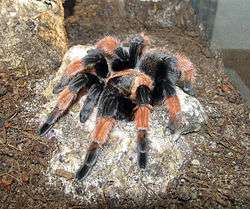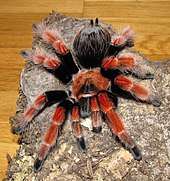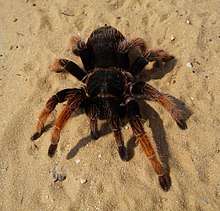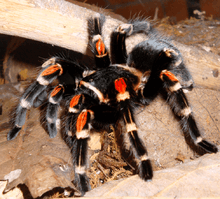Brachypelma
| Brachypelma | |
|---|---|
 | |
| Juvenile male B. emilia, in captivity | |
| Scientific classification | |
| Kingdom: | Animalia |
| Phylum: | Arthropoda |
| Subphylum: | Chelicerata |
| Class: | Arachnida |
| Order: | Araneae |
| Infraorder: | Mygalomorphae |
| Family: | Theraphosidae |
| Genus: | Brachypelma Simon, 1891[1] |
| Species | |
|
See text. | |
| Diversity[1] | |
| 18 species | |
| Synonyms | |
|
Brachypelmides Schmidt & Krause, 1994 | |
Brachypelma is a genus of spiders in the family Theraphosidae (tarantulas), found in Mexico and Central America. They may have bodies up to 6 cm (2 1⁄4 in) long with legs of similar or greater lengths. Some species have brightly colored legs, with red or orange marks and rings. The taxonomy of the genus and its species has been the subject of considerable debate. As of October 2017, the genus contained 18 species, which fall into two groups: "red leg" tarantulas (Brachypelma sensu stricto) and "red rump" tarantulas (which may need to be transferred to another genus). Many species are popular with tarantula keepers as pets; the females in particular are long lived. All species of Brachypelma are protected, and trade is regulated under CITES. Although they are bred in captivity, they continue to be exported in large numbers. Members of the "red leg" group are considered to be in most urgent need of further conservation efforts.
Description

Brachypelma species are noted for their large size, colorfulness and docility in captivity.[2] Members of the family Theraphosidae, the tarantulas, to which Brachypelma belongs, are generally large compared to other spiders, and are commonly seen as "objects of dread". Tarantulas do not use webs for capturing their prey, relying on their venom and their size and strength.[3] Larger species of Brachypelma, such as B. smithi, have body lengths in the approximate range 45–60 mm (1 3⁄4–2 1⁄4 in) with legs up to 70 mm (2 3⁄4 in) long. Females on average have longer bodies than males but shorter legs.[4] B. kahlenbergi is one of the smaller species, with body lengths around 30–40 mm (1 1⁄4–1 1⁄2 in).[5]
The "red leg" group contains species with bright red markings on their legs. B. boehmei has been described as the "most gorgeous" species of the genus.[2] The parts of the legs closest to the body are black, then three segments (the patellae, tibiae and metatarsi) are bright orange-yellow, followed by black tarsi. Although brightly colored, Brachypelma species are cryptic when in their native habitat.[6]
Diagnosis
The distribution of hairs on the legs and palp and the shape of the male and female genitalia are the diagnostic features of the broadly defined genus. The prolateral (forward facing) surface of the trochanter and femur of the first leg and the retrolateral surface of the pedipalp have plumose hairs, and there is no pad of plumose hairs on the femur of the fourth leg. The male palpal bulb has a flattened, spoon-shaped embolus; females have fused spermathecae, with a flat cross-section.[7]
Life history
All the species of Brachypelma that have been studied in detail live in burrows. These have a single entrance, a little larger than the spider, opening into a horizontal tunnel that usually leads to two chambers: one where it molts and one where it rests and consumes its prey. The entrance is blocked with material, such as soil and leaves, bound together by silk when the spider is inactive for significant length of time; otherwise the entrance is open with some silk visible.[6] North American tarantulas like Brachypelma are "sit and wait" predators, seizing prey passing by the burrow entrance.[8]
Compared to related genera, Brachypelma species are long-lived. The maximum life-span recorded in two Berlin zoos was 12 years for Brachypelma annitha (now a synonym of B. smithi).[9] In the wild, females take around 9–10 years to reach maturity, but can then live for another 10 years.[6] Males can take 7–8 years to reach maturity, afterwards usually dying within a year,[6] probably because when mature they actively seek mates and rarely feed while doing so, whereas females remain around their burrows.[9]
Studies on Mexican species in the wild showed that pre-adult and adult spiders molt towards the end of the dry season, which lasts from June to November. After their last molt, adult males search for females, the west coast species travelling in the daytime, particularly in the morning and evening, and the east coast species travelling at night. Females produce an egg sac before they molt. The eggs hatch a few weeks before the rainy season begins.[6] The spiderlings molt every two weeks for the first few months, then less frequently as they mature. A full-grown Brachypelma may molt as infrequently as once a year.
Taxonomy
The genus Brachypelma was erected by Eugène Simon in 1891 for the species Mygale emilia, originally described in 1856.[1] The genus has not always been recognized. In 1897, Frederick Pickard-Cambridge considered Brachypelma to be a synonym of Eurypelma, regarding the two as not distinct from one another.[10] (Eurypelma is now a synonym of Avicularia.) In 1903, Reginald Pocock recognized Brachypelma, listing four species and noting that there were more.[11] Other arachnologists, like Robert Raven in his 1985 monograph of Mygalomorphae, treated Brachypelma as a synonym of Euathlus.[12] In 1992, Günter Schmidt clarified the difference between Euathlus and Brachypelma,[13] resulting in the latter's acceptance as a distinct genus.[1]
The genus Brachypelmides, erected by Schmidt and Krause in 1994, is considered a synonym of Brachypelma by some sources, including the World Spider Catalog, although this has been rejected by Schmidt.[1] When broadly defined, Brachypelma is distinguished from related genera by the plumose setae (hairs) on the prolateral (forward-facing) side of the trochanter and femur of the first leg and on the retrolateral (outward-facing) side of the pedipalp.[4]
A 2017 study concluded that the genus Brachypelma is not monophyletic, and that only eight "red leg" species belong in Brachypelma sensu stricto, the remaining species (the "red rump" group) being misplaced. As of October 2017, no other genus had been proposed.[14]
DNA barcoding
In 2017, Mendoza and Francke applied DNA barcoding to some Mexican species of Brachypelma. In this approach, a portion of about 650 base pairs of the mitochondrial gene cytochrome oxidase I (COI) is used, primarily to identify existing species, but also sometimes to support a separation between species. One cladogram resulting from the DNA barcodes is shown below. Although B. hamorii and B. smithi are very similar in external appearance and have not always been treated as separate species, they are clearly distinguished by their DNA barcodes.[4] All the species in the cladogram below belong to the "red leg" group.[14]

|
| ||||||||||||||||||||||||||||||||||
Phylogeny
In 2017, Steven Turner and colleagues reported on a phylogenetic analysis of the family Theraphosidae based on mitochondrial DNA. A cladogram based on Bayesian analysis of a sample within their proposed tribe Theraphosini is shown below.[14]
|
| |||||||||||||||||||||||||||||||||||||||||||||||||
The cladogram shows that the genus Brachypelma is not monophyletic, but falls into two distinct clades. All analyses supported the view that Brachypelma (along with Aphonopelma) was made up of deeply divergent subgroups. Detailed analysis further suggested that the species in the "red rump" group were closely related, with several supposed species, particularly those labeled "Brachypelma vagans", not being monophyletic. The authors cautioned that the necessary use of specimens obtained through the commercial pet trade meant that their exact geographical origins were often unknown, leading to uncertainty as to their identification.[14]
Species


As of July 2017, the World Spider Catalog accepted the species listed below.[1] The division into two groups is based on Turner et al. (2017).[14]
- "Red leg" group = Brachypelma sensu stricto
- Brachypelma albiceps Pocock, 1903 – Mexico
- Brachypelma auratum Schmidt, 1992 – Mexico
- Brachypelma baumgarteni Smith, 1993 – Mexico
- Brachypelma boehmei Schmidt & Klaas, 1993 – Mexico
- Brachypelma emilia (White, 1856) (type species) – Mexico
- Brachypelma hamorii Tesmoingt, Cleton & Verdez, 1997 – Mexico
- Brachypelma klaasi (Schmidt & Krause, 1994) – Mexico
- Brachypelma smithi (F. O. Pickard-Cambridge, 1897) – Mexico
- "Red rump" group
- Brachypelma albopilosum Valerio, 1980 – Costa Rica
- Brachypelma andrewi Schmidt, 1992 – Unknown
- Brachypelma aureoceps (Chamberlin, 1917) – USA (probably introduced)
- Brachypelma epicureanum (Chamberlin, 1925) – Mexico
- Brachypelma fossorium Valerio, 1980 – Costa Rica
- Brachypelma kahlenbergi Rudloff, 2008 – Mexico
- Brachypelma sabulosum (F. O. Pickard-Cambridge, 1897) – Guatemala
- Brachypelma schroederi Rudloff, 2003 – Mexico
- Brachypelma vagans (Ausserer, 1875) – Mexico, Central America
- Brachypelma verdezi Schmidt, 2003 – Mexico

"Red leg" group
██ Brachypelma albiceps
██ Brachypelma auratum
██ Brachypelma baumgarteni
██ Brachypelma boehmei
██ Brachypelma emilia
██ Brachypelma hamorii
██ Brachypelma klaasi
██ Brachyplema smithi
"Red rump" group
██ Brachypelma epicureanum
██ Brachypelma vagans
Two species have been moved to the genus Sericopelma:[1]
- Brachypelma angustum Valerio, 1980 → Sericopelma angustum
- Brachypelma embrithes (Chamberlin & Ivie, 1936) → Sericopelma embrithes
Distribution
Most species of Brachypelma are found in Mexico, with four species further south in Central America, and one species probably from Mexico but collected in the United States.[1][15] Within Mexico, the largest number of species are found along the Pacific coast.[6] In particular, the majority of the "red leg" group are restricted to small endemic ranges in this area.[14]
There is uncertainty over both the distribution of some Brachypelma species and their identity. Stuart Longhorn has criticized several arachnologists, including Günter Schmidt, for describing new species based on pet-trade specimens without accurate locations, resulting in vague or inaccurate distributions. He argues that locality information is vital for "scientific rigor", since without it important questions relating to the identity of species cannot be answered.[16] Steven Turner and colleagues have also noted difficulties in identification resulting from the use of imprecisely sourced pet-trade specimens.[14]
Conservation
Habitat destruction and collection for the pet trade have led to these spiders being among the few arthropods protected under international Convention on International Trade of Endangered Species rules. In 1985, B. smithi (then not distinguished from B. hamorii) was placed on CITES Appendix II, and in 1994, all remaining Brachypelma species were added.[17] Large numbers of Mexican tarantulas caught in the wild continue to be smuggled out of Mexico. It is reported that at least 3,000 specimens of Mexican tarantulas were sent to the United States or Europe a few years prior to 2017, most of which were Mexican red knee tarantulas (B. hamorii and B. smithi).[4] Turner and colleagues suggest that members of their "red leg" group, which have small ranges and are slow to mature and reproduce, should be the focus of urgent conservation measures, with threats to species in the "red rump" group possibly being downgraded.[14]
In captivity
Brachypelma species are docile tarantulas which are easy to keep in a terrarium. The best-known species in this genus are the Mexican red knee tarantulas B. hamorii and B. smithi, curly hair B. albopilosum, and the Mexican red rump B. vagans. They feed on smaller invertebrates and occasionally vertebrates, but while insects are the norm, they may also eat lizards or frogs. These species, like most tarantulas, are cannibalistic, so in captivity, individuals must be kept singly, though brief captive introductions of a mate for breeding purposes can prove unproblematic, so long as they are separated once mating has occurred.
Large spiders used in Hollywood movies (e.g., Indiana Jones series, The Mummy Returns) are often Brachypelma hamorii or Brachypelma emilia because they are very docile, though the much less expensive and only moderately more aggressive Chilean rose tarantula is frequently used, as well. While it is almost unheard of for a Brachypelma to bite a human, they are quick to kick urticating hairs in self-defense, though their hairs can be less irritating than those of other species, especially the goliath birdeater.
See also
References
- 1 2 3 4 5 6 7 8 "Gen. Brachypelma Simon, 1891", World Spider Catalog, Natural History Museum Bern, retrieved 2017-09-27
- 1 2 West, Rick C. (2005), "Brachypelma of Mexico", Journal of the British Tarantula Society, 20 (4): 108–119, retrieved 2017-10-08
- ↑ Escoubas, Pierre & Rash, Lachlan (2004), "Tarantulas: eight-legged pharmacists and combinatorial chemists", Toxicon, 43 (5): 555–574, doi:10.1016/j.toxicon.2004.02.007, retrieved 2017-10-08
- 1 2 3 4 Mendoza, J. & Francke, O. (2017), "Systematic revision of Brachypelma red-kneed tarantulas (Araneae: Theraphosidae), and the use of DNA barcodes to assist in the identification and conservation of CITES-listed species", Invertebrate Systematics, 31 (2): 157–179, doi:10.1071/IS16023 , Abstract
- ↑ Rudloff, J.-P. (2008), "Eine neue Brachypelma-Art aus Mexiko (Araneae: Mygalomorphae: Theraphosidae: Theraphosinae)", Arthropoda (in German), 16 (2): 26–30
- 1 2 3 4 5 6 Locht, A.; Yáñez, M. & Vázquez, I. (1999), "Distribution and natural history of Mexican species of Brachypelma and Brachypelmides (Theraphosidae, Theraphosinae) with morphological evidence for their synonymy", Journal of Arachnology, 27: 196–200
- ↑ Gabriel, Ray & Longhorn, Stuart J. (2015), "Revised generic placement of Brachypelma embrithes (Chamberlin & Ivie, 1936) and Brachypelma angustum Valerio, 1980, with definition of the taxonomic features for identification of female Sericopelma Ausserer, 1875 (Araneae, Theraphosidae)", ZooKeys, 526: 75–104, doi:10.3897/zookeys.526.6315, PMC 4607846, PMID 26487826
- ↑ Smith, Andrew M. (1995), Tarantula Spiders : Tarantulas of the U.S.A. and Mexico, London: Fitzgerald Publishing, ISBN 09510939-9-1
- 1 2 Ibler, Benjamin; Michalik, Peter & Fischer, Klaus (2013), "Factors affecting lifespan in bird-eating spiders (Arachnida: Mygalomorphae, Theraphosidae) – A multi-species approach", Zoologischer Anzeiger, 253 (2): 126–136, doi:10.1016/j.jcz.2013.09.004
- ↑ Pickard-Cambridge, F. O. (1897), "Eurypelma smithi, sp.n.", Arachnida - Araneida and Opiliones, vol. 2, Biologia Centrali-Americana, London, p. 20
- ↑ Pocock, R. I. (1903), "On some genera and species of South-American Aviculariidae", Annals and Magazine of Natural History, Series 7, 11: 81–115, doi:10.1080/00222930308678729
- ↑ Raven, R. J. (1985), "The spider infraorder Mygalomorphae (Araneae): Cladistics and systematics", Bulletin of the American Museum of Natural History, 182: 1–180, retrieved 2016-01-18
- ↑ Schmidt, G. (1992), "Brachypelma Simon 1890 oder Euathlus Ausserer 1875? (Araneida: Theraphosidae: Theraphosinae)", Arachnologischer Anzeiger (in German), 3 (1): 9–11
- 1 2 3 4 5 6 7 8 Turner, Steven P.; Longhorn, Stuart J.; Hamilton, Chris A.; Gabriel, Ray; Pérez-Miles, Fernando & Vogler, Alfried P. (2017), "Re-evaluating conservation priorities of New World tarantulas (Araneae: Theraphosidae) in a molecular framework indicates non-monophyly of the genera, Aphonopelma and Brachypelma", Systematics and Biodiversity, 16 (1): 1–19, doi:10.1080/14772000.2017.1346719
- ↑ Smith, Andrew M. (1994), Tarantula Spiders: Tarantulas of the U.S.A. and Mexico, London: Fitzgerald Publishing, ISBN 978-0-9510939-9-3
- ↑ Longhorn, Stuart J. (2014), "On type localities of Mexican tarantulas, either missing for Bonnetina, or misleading for Brachypelma, with appeal for accurate biogeographic data" (PDF), British Tarantula Society Journal, 29 (1): 16–28, retrieved 2017-10-05
- ↑ "Brachypelma smithi (F. O. Pickard-Cambridge, 1897): Documents", Species+, UNEP-WCMC & CITES Secretariat, retrieved 2017-09-22